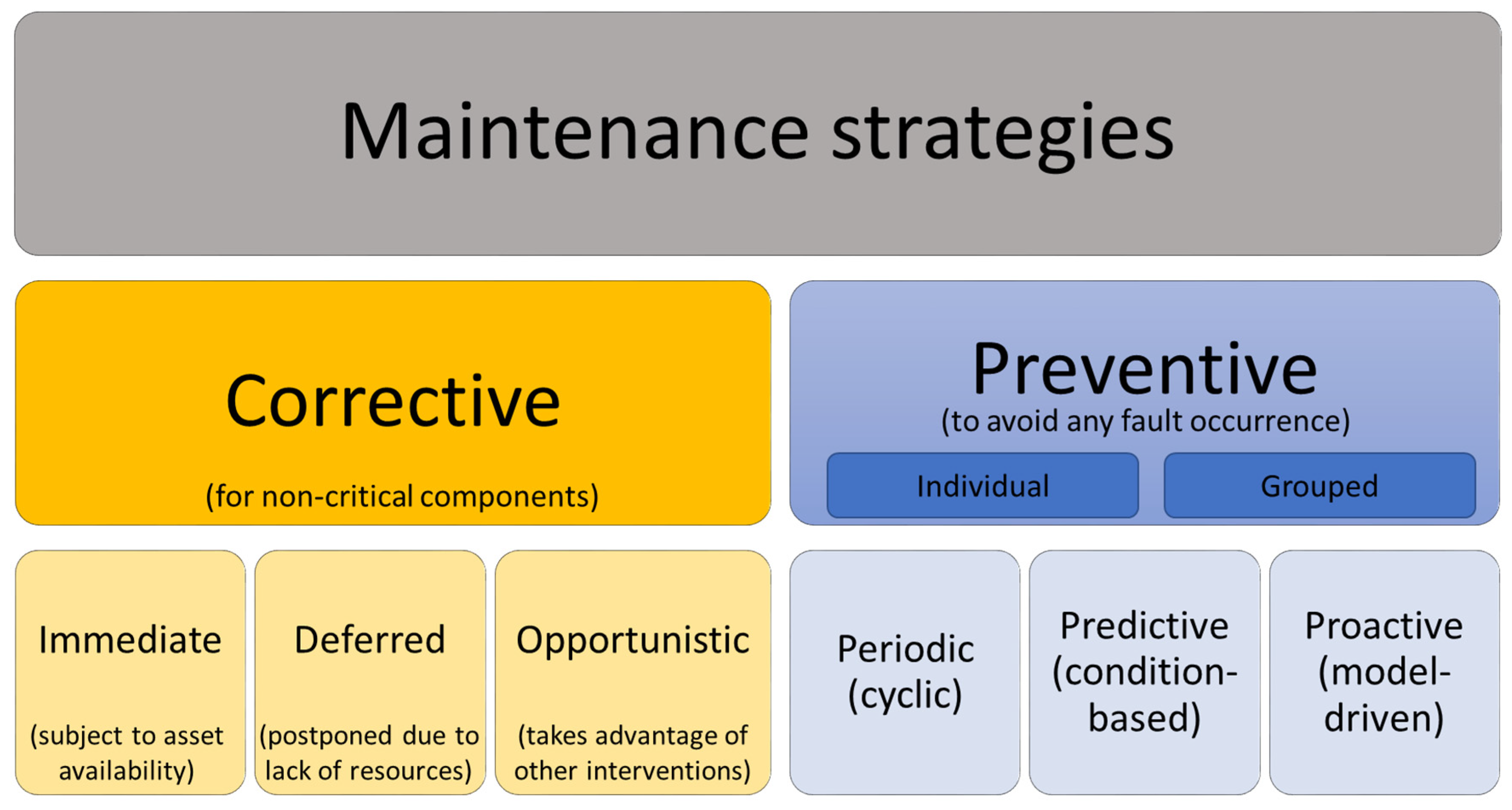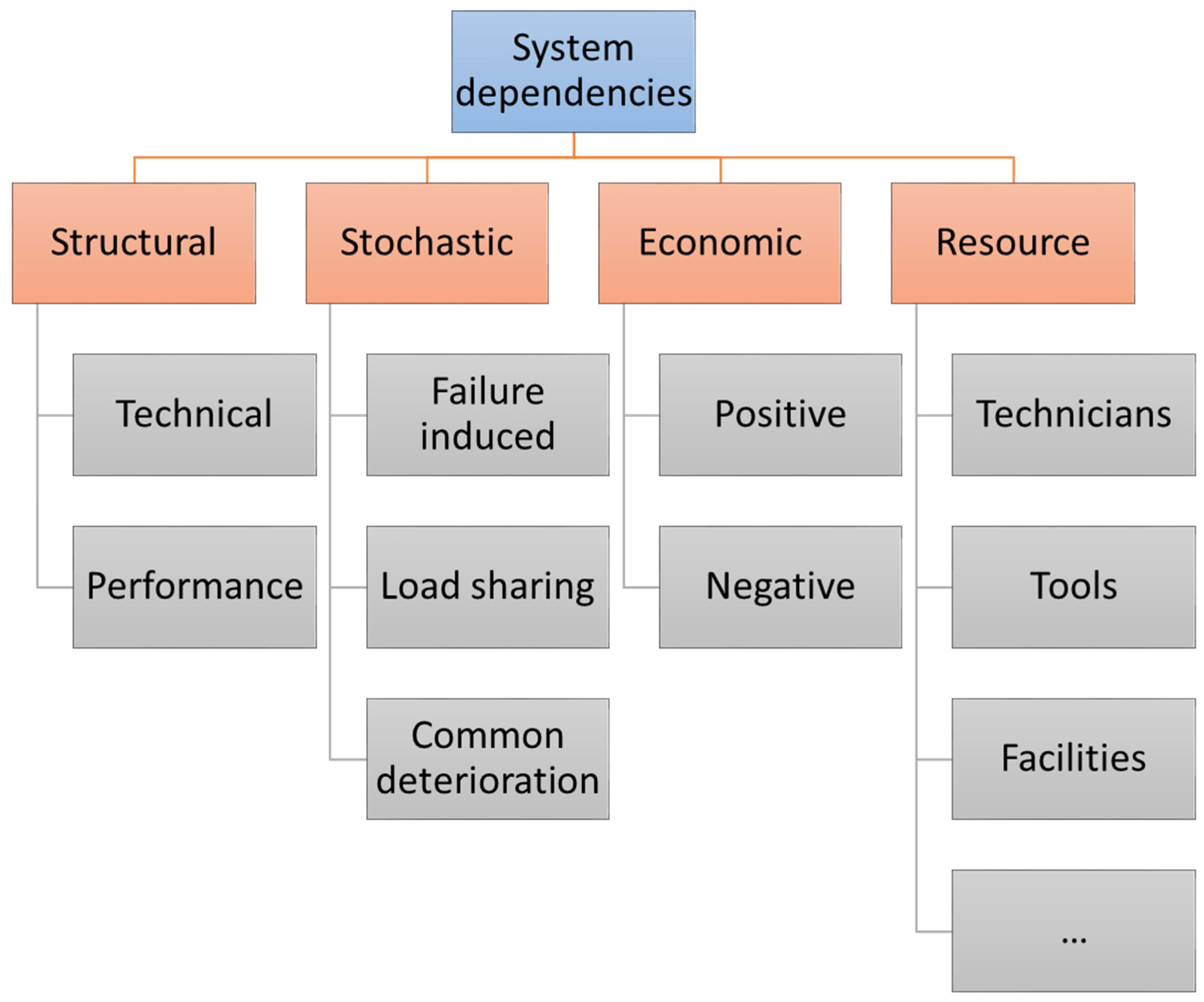Current Status and Future Trends in the Operation and Maintenance of Offshore Wind Turbines: A Review
Abstract
1. Introduction
- to provide an overview of the different aspects of ORE maintenance for early inclusion in the planning of offshore renewables O&M;
- to review and summarise the advancements in maintenance planning in other industries in order to identify synergies for the ORE sector;
- to expand the existing literature on condition monitoring and condition-based maintenance for ORE to the novel floating offshore wind (FLOW) sector;
- to assess current efforts towards automation and digitalisation, providing a detailed impression of the opportunities and challenges in applying Industry 4.0 concepts to the offshore maintenance sector.
2. Research Methodology
3. Operation and Maintenance of Offshore Renewable Energy Farms
3.1. Maintenance Strategies
3.2. Computational Tools for O&M Planning
3.3. Condition-Based Maintenance and System Dependencies
- Data collection from CM systems and subsequent signal processing to extract relevant information. This includes fault diagnosis;
- Reliability modelling to capture deterioration and predict failures. This includes fault prognosis and subsequent verification with the existing dataset;
- Decision making towards maintenance optimisation. This includes inspection and preventive maintenance schedules.
- Structural or functional dependence—a component stops functioning as a consequence of another dependent component stopping due to failure (technical) or maintenance (performance). In this case, maintenance on the non-dependent component might be required pre- or post-intervention on the dependent component;
- Stochastic dependence—the deterioration of one component has an effect on other components. Common ways in which this can happen are a direct fault (failure-induced damage), due to an increase in the workload shared until that moment (load sharing) and mutual (common-mode) deterioration [32]. In this case, the degradation of dependent components can be modelled using a joint probability distribution [51];
- Economic dependence—maintenance for multiple components is either cheaper (positive economic dependence) or more expensive (negative economic dependence) than maintaining the same components individually;
- Resource dependence—maintenance is constrained by a limited amount of a certain resource, e.g., spare parts, tools and technicians.
3.4. Condition Monitoring, Structural Health Monitoring and SCADA Systems
- Vibration analysis. Exploits accelerometers and piezoelectric or micro-electromechanical systems (MEMS) to monitor the drivetrain, gearbox and bearings;
- Oil quality analysis and oil particle counters. To monitor lubrication status in mechanical components;
- Acoustic emissions. To detect possible flaws and imperfections during operation, such as cracks, impacts or excessive deformations;
- Ultrasonic testing. To reveal possible cracks and assess the interior structures of components like blades, tower and support structure;
- Temperature analysis and thermography. To detect thermal fluctuations or anomalies in both mechanical and electrical components;
- Modal Properties Monitoring. To assess possible changes in mass or stiffness of the structural components which can affect modal parameters such as damping coefficient and resonance frequency. It is achieved by means of accelerometers that monitor the dynamic response of the structure, or piezoelectric materials which can detect structural damage;
- Humidity analysis. To characterise the level of moisture in the air and assess eventual corrosion hazards;
- Strain measurement. To measure bending and length variations in blades and other structural components using fibre-optic or strain gauges, since these can affect the stresses and loads on the materials;
- Electric signals measurement. It includes time and frequency domain analysis of the electric power, voltage and current. These measurements are used to make sure that the farm complies with the grid requirements and the energy transmission is stable. This ensures a high-quality power generation and preserves peripheral systems, e.g., substations. But it can also be used to detect mechanical faults, e.g., in the generator.
- High degree of modularity
- If possible, plug and play
- Use of open standards
- Ease of configuration
- Generic solution for module configuration
- Generic interfaces for modules/data
- Platform independence
- Modern software architecture
- Possible remote software updates
- Many levels of access and security
- Self-starting and stable
3.4.1. Offshore Wind
3.4.2. Floating Offshore Wind
3.4.3. Other Marine Renewables
3.4.4. Novel Tools and Approaches
3.5. Diagnosis and Prognosis
3.6. Deterioration Models
4. Maintenance in Other Industries
- Appropriate sensors to monitor the machines are selected together with a suitable data acquisition system.
- Cleaning, integrations, reduction and transformation techniques are used to pre-process the data produced by all the sensors. This ensures that the data volume is reduced to the relevant parts.
- Data mining is used in combination with model-based techniques for fault detection, classification and prediction.
- A diagram of the key performance indicators describing the situation and health condition of the equipment is produced for performance evaluation. Maintenance planning can thus be proposed by using optimisation techniques, e.g., evolutionary algorithms (genetic algorithms, particle swarm optimisation, ant colony optimisation, bee colony algorithm, etc.).
- Maintenance is implemented according to the selected strategy. The effects of data and decisions, until now transmitted and elaborated only virtually, are now transferred back to physical systems in the real world.
4.1. Soft Sensors
4.2. Data Mining, AI and Robotics
4.3. Industry 4.0
- Interoperability, amongst real-virtual (cyber–physical) systems and humans;
- Virtualization, of plant and machine models;
- Decentralization, to enable decisions at different levels;
- Real-time capability, to analyse and process data instantaneously;
- Service orientation, to tailor products according to the customer preferences;
- Modularity, to allow for flexibility and easy adaptation to changing conditions; and
- Security, to guarantee safe and secure transmission of private data.
4.4. IoT and Big Data
5. Discussion
6. Conclusions
Author Contributions
Funding
Institutional Review Board Statement
Informed Consent Statement
Data Availability Statement
Acknowledgments
Conflicts of Interest
References
- Renewables Consulting Group. Global Offshore Wind: Annual Market Report. Glob. Offshore Wind Rep. 2020, 2020, 130. [Google Scholar]
- Wind Europe. Offshore Wind in Europe–Key Trends and Statistics; Wind Europe: Brussels, Belgium, 2019. [Google Scholar] [CrossRef]
- Hannon, M.; Topham, E.; Dixon, J.; Mcmillan, D.; Collu, M.; Topham, E. Offshore wind, ready to float? Global and UK trends in the floating offshore wind market. Glasgow 2019. [Google Scholar] [CrossRef]
- Röckmann, C.; Lagerveld, S.; Stavenuiter, J. Operation and Maintenance Costs of Offshore Wind Farms and Potential Multi-use Platforms in the Dutch North Sea. In Aquac. Perspect. Multi-Use Sites Open Ocean Untapped Potential Marine Resources Anthropocene; Buck, B.H., Langan, R., Eds.; Springer International Publishing: Cham, Germany, 2017; pp. 97–113. [Google Scholar] [CrossRef]
- Rademakers, L.W.M.M.; Braam, H. O&M aspects of the 500 MW offshore wind farm at NL7 Baseline Configuration; Technical Report DOWEC Report Nr. 10080 rev 2; ECN & TU: Petten, The Netherlands, 2002; Volume 7. [Google Scholar]
- Rinaldi, G.; Thies, P.R.; Johanning, L.; Walker, R.T. A computational tool for the pro-active management of offshore farms. In Proceedings of the 2nd International Conference Offshore Renewable Energy, Glasgow, UK, 19–20 September 2016; pp. 111–115. [Google Scholar]
- Tranfield, D.; Denyer, D.; Smart, P. The modern approach to industrial maintenance management. Br. J. Manag. 2003, 14, 207–222. [Google Scholar] [CrossRef]
- Dekker, R. Applications of maintenance optimization models: A review and analysis. Reliab. Eng. Syst. Saf. 1996, 51, 229–240. [Google Scholar] [CrossRef]
- Lyonnet, P. Maintenance Planning: Methods and Mathematics; Springer Science & Business Media: Berlin, Germany, 2013. [Google Scholar]
- Yamayee, Z.; Sidenblad, K.; Yoshimura, M. A computationally efficient optimal maintenance scheduling method. IEEE Trans. Power Appar. Syst. 1983, 102, 330–338. [Google Scholar] [CrossRef]
- De Jonge, B.; Scarf, P.A. A review on maintenance optimization. Eur. J. Oper. Res. 2020, 285, 805–824. [Google Scholar] [CrossRef]
- Wang, H. A survey of maintenance policies of deteriorating systems. Eur. J. Oper. Res. 2002, 139, 469–489. [Google Scholar] [CrossRef]
- Ayu, K.; Yunusa-Kaltungo, A. A Holistic Framework for Supporting Maintenance and Asset Management Life Cycle Decisions for Power Systems. Energies 2020, 13, 1937. [Google Scholar] [CrossRef]
- Takata, S.; Kimura, F.; Van Houten, F.; Westkämper, E.; Shpitalni, M.; Ceglarek, D.; Lee, J. Maintenance: Changing role in life cycle management. Ann. CIRP 2004, 53, 643–656. [Google Scholar] [CrossRef]
- Hameed, Z.; Ahn, S.H.; Cho, Y.M. Practical aspects of a condition monitoring system for a wind turbine with emphasis on its design, system architecture, testing and installation. Renew. Energy 2010, 35, 879–894. [Google Scholar] [CrossRef]
- Van Horenbeek, A.; Pintelon, L. A dynamic predictive maintenance policy for complex multi-component systems. Reliab. Eng. Syst. Saf. 2013, 120, 39–50. [Google Scholar] [CrossRef]
- Lawrence, M.; Anuj, S.M.K.G. Statistical-based or condition-based preventive maintenance? J. Qual. Maint. Eng. 1995, 1, 46–59. [Google Scholar] [CrossRef]
- Scheu, M.N.; Tremps, L.; Smolka, U.; Kolios, A.; Brennan, F. A systematic Failure Mode Effects and Criticality Analysis for offshore wind turbine systems towards integrated condition based maintenance strategies. Ocean Eng. 2019, 176, 118–133. [Google Scholar] [CrossRef]
- Rinaldi, G. An Integrated Pperation and Maintenance Framework for Offshore Renewable Energy; University of Exeter: Exeter, UK, 2018. [Google Scholar]
- Nakagawa, T.; Murthy, D.N.P. Optimal replacement policies for a two-unit system with failure interactions. RAIRO Oper. Res. 1993, 27, 427–438. [Google Scholar] [CrossRef][Green Version]
- Sheu, S.-H.; Jhang, J.-P. A generalized group maintenance policy. Eur. J. Oper. Res. 1997, 96, 232–247. [Google Scholar] [CrossRef]
- Shafiee, M. Maintenance logistics organization for offshore wind energy: Current progress and future perspectives. Renew. Energy 2015, 77, 182–193. [Google Scholar] [CrossRef]
- Rinaldi, G.; Pillai, A.C.; Thies, P.R.; Johanning, L. Multi-objective optimization of the operation and maintenance assets of an offshore wind farm using genetic algorithms. Wind Eng. 2019, 1–20. [Google Scholar] [CrossRef]
- Rinaldi, G.; Thies, P.R.; Walker, R.; Johanning, L. On the Analysis of a Wave Energy Farm with Focus on Maintenance Operations. J. Mar. Sci. Eng. 2016, 4, 51. [Google Scholar] [CrossRef]
- Rinaldi, G.; Thies, P.R.; Walker, R.; Johanning, L. A decision support model to optimise the operation and maintenance strategies of an offshore renewable energy farm. Ocean Eng. 2017, 145, 250–262. [Google Scholar] [CrossRef]
- Rinaldi, G.; Thies, P.R.; Johanning, L. A coupled Monte Carlo–Evolutionary Algorithm approach to optimise offshore renewables O & M. In Proceedings of the 12th European Wave Tidal Energy Conference, Cork, Ireland, 19–20 May 2017; pp. 1–7. [Google Scholar]
- Hofmann, M. A Review of Decision Support Models for Offshore Wind Farms with an Emphasis on Operation and Maintenance Strategies. Wind Eng. 2011, 35, 1–16. [Google Scholar] [CrossRef]
- Welte, T.M.; Sperstad, I.B.; Halvorsen-Weare, E.E.; Netland, Ø.; Nonås, L.M.; Stålhane, M. Operation and Maintenance Modelling. Offshore Wind Energy Technol. 2018, 269–303. [Google Scholar] [CrossRef]
- Seyr, H.; Muskulus, M. Decision Support Models for Operations and Maintenance for Offshore Wind Farms: A Review. Appl. Sci. 2019, 9, 278. [Google Scholar] [CrossRef]
- Athanasios, K.; Brennan, F. Deliverable Report D8.1: Review of Existing Cost and O&M Models, and Development of a High-Fidelity Cost/Revenue Model for Impact Assessment. 2018. Available online: https://romeoproject.eu/wp-content/uploads/2018/12/D8.1_ROMEO_Report-reviewing-exsiting-cost-and-OM-support-models.pdf (accessed on 30 April 2020).
- Pfaffel, S.; Faulstich, S.; Rohrig, K. Performance and Reliability of Wind Turbines: A Review. Energies 2017, 10, 1904. [Google Scholar] [CrossRef]
- Olde Keizer, M.C.A.; Flapper, S.D.P.; Teunter, R.H. Condition-based maintenance policies for systems with multiple dependent components: A review. Eur. J. Oper. Res. 2017, 261, 405–420. [Google Scholar] [CrossRef]
- Mérigaud, A.; Ringwood, J.V. Condition-based maintenance methods for marine renewable energy. Renew. Sustain. Energy Rev. 2016, 66, 53–78. [Google Scholar] [CrossRef]
- Blanco, M.A.; Marti-Puig, P.; Gibert, K.; Cusidó, J.; Solé-Casals, J. A Text-Mining Approach to Assess the Failure Condition of Wind Turbines Using Maintenance Service History. Energies 2019, 12, 1982. [Google Scholar] [CrossRef]
- Peng, Y.; Dong, M.; Zuo, M.J. Current status of machine prognostics in condition-based maintenance: A review. Int. J. Adv. Manuf. Technol. 2010, 50, 297–313. [Google Scholar] [CrossRef]
- Castanier, B.; Grall, A.; Bérenguer, C. A condition-based maintenance policy with non-periodic inspections for a two-unit series system. Reliab. Eng. Syst. Saf. 2005, 87, 109–120. [Google Scholar] [CrossRef]
- Ahmad, R.; Kamaruddin, S. An overview of time-based and condition-based maintenance in industrial application. Comput. Ind. Eng. 2012, 63, 135–149. [Google Scholar] [CrossRef]
- Chen, N.; Ye, Z.S.; Xiang, Y.; Zhang, L. Condition-based maintenance using the inverse Gaussian degradation model. Eur. J. Oper. Res. 2015, 243, 190–199. [Google Scholar] [CrossRef]
- Zhao, X.; Fouladirad, M.; Bérenguer, C.; Bordes, L. Condition-based inspection/replacement policies for non-monotone deteriorating systems with environmental covariates. Reliab. Eng. Syst. Saf. 2010, 95, 921–934. [Google Scholar] [CrossRef]
- Bouvard, K.; Artus, S.; Bérenguer, C.; Cocquempot, V. Condition-based dynamic maintenance operations planning & grouping. Application to commercial heavy vehicles. Reliab. Eng. Syst. Saf. 2011, 96, 601–610. [Google Scholar] [CrossRef]
- Lu, Y.; Sun, L.; Zhang, X.; Feng, F.; Kang, J.; Fu, G. Condition based maintenance optimization for offshore wind turbine considering opportunities based on neural network approach. Appl. Ocean Res. 2018, 74, 69–79. [Google Scholar] [CrossRef]
- De Jonge, B.; Teunter, R.; Tinga, T. The influence of practical factors on the benefits of condition-based maintenance over time-based maintenance. Reliab. Eng. Syst. Saf. 2017, 158, 21–30. [Google Scholar] [CrossRef]
- Xu, M.; Jin, X.; Kamarthi, S.; Noor-E-Alam, M. A failure-dependency modeling and state discretization approach for condition-based maintenance optimization of multi-component systems. J. Manuf. Syst. 2018, 47, 141–152. [Google Scholar] [CrossRef]
- Jardine, A.K.S.; Daming, L.; Dragan, B. A review on machinery diagnostics and prognostics implementing condition-based maintenance. Mech. Syst. Signal. Process. 2006, 20, 1483–1510. [Google Scholar] [CrossRef]
- Ruschel, E.; Santos, E.A.P.; Loures, E.d.F.R. Industrial maintenance decision-making: A systematic literature review. J. Manuf. Syst. 2017, 45, 180–194. [Google Scholar] [CrossRef]
- Amirat, Y.; Benbouzid, M.E.H.; Al-Ahmar, E.; Bensaker, B.; Turri, S. A brief status on condition monitoring and fault diagnosis in wind energy conversion systems. Renew. Sustain. Energy Rev. 2009, 13, 2629–2636. [Google Scholar] [CrossRef]
- Cibulka, J.; Ebbesen, M.K.; Hovland, G.; Robbersmyr, K.G.; Hansen, M.R. A review on approaches for condition based maintenance in applications with induction machines located offshore. Model. Identif. Control 2012, 33, 69–86. [Google Scholar] [CrossRef]
- Alaswad, S.; Xiang, Y. A review on condition-based maintenance optimization models for stochastically deteriorating system. Reliab. Eng. Syst. Saf. 2017, 157, 54–63. [Google Scholar] [CrossRef]
- Marseguerra, M.; Zio, E.; Podofillini, L. Condition-based maintenance optimization by means of genetic algorithms and Monte Carlo simulation. Reliab. Eng. Syst. Saf. 2002, 77, 151–165. [Google Scholar] [CrossRef]
- Camci, F. System Maintenance Scheduling With Prognostics Information Using Genetic Algorithm. IEEE Trans. Reliab. 2009, 58, 539–552. [Google Scholar] [CrossRef]
- Rasmekomen, N.; Parlikad, A.K. Condition-based maintenance of multi-component systems with degradation state-rate interactions. Reliab. Eng. Syst. Saf. 2016, 148, 1–10. [Google Scholar] [CrossRef]
- Wiggelinkhuizen, E.; Verbruggen, T.; Braam, H.; Rademakers, L.; Xiang, J.; Watson, S. CONMOW: Condition monitoring for offshore wind farms. In Proceedings of the European Wind Energy Conference, Milan, Italy, 7–10 May 2007; Volume 164, pp. 210–219. [Google Scholar]
- Yang, W. Condition monitoring of offshore wind turbines. Offshore Wind Farms–Technol. Des. Oper. 2016, 543–572. [Google Scholar] [CrossRef]
- Wymore, M.L.; Van Dam, J.E.; Ceylan, H.; Qiao, D. A survey of health monitoring systems for wind turbines. Renew. Sustain. Energy Rev. 2015, 52, 976–990. [Google Scholar] [CrossRef]
- Yang, W.; Tavner, P.J.; Crabtree, C.J.; Feng, Y.; Qiu, Y. Wind turbine condition monitoring: Technical and commercial challenges. Wind Energy 2014, 17, 673–693. [Google Scholar] [CrossRef]
- Hameed, Z.; Hong, Y.S.; Cho, Y.M.; Ahn, S.H.; Song, C.K. Condition monitoring and fault detection of wind turbines and related algorithms: A review. Renew. Sustain. Energy Rev. 2009, 13, 1–39. [Google Scholar] [CrossRef]
- Martinez-Luengo, M.; Kolios, A.; Wang, L. Structural health monitoring of offshore wind turbines: A review through the Statistical Pattern Recognition Paradigm. Renew. Sustain. Energy Rev. 2016, 64, 91–105. [Google Scholar] [CrossRef]
- García Márquez, F.P.; Tobias, A.M.; Pinar Pérez, J.M.; Papaelias, M. Condition monitoring of wind turbines: Techniques and methods. Renew. Energy 2012, 46, 169–178. [Google Scholar] [CrossRef]
- Ghoshal, A.; Sundaresan, M.J.; Schulz, M.J.; Frank Pai, P. Structural health monitoring techniques for wind turbine blades. J. Wind Eng. Ind. Aerodyn. 2000, 85, 309–324. [Google Scholar] [CrossRef]
- Smolka, U.; Cheng, P.W. On the Design of Measurement Campaigns for Fatigue Life Monitoring of Offshore Wind Turbines. In Proceedings of the Twenty-Third International Offshore and Polar Engineering Conference, Anchorage, AL, USA, 30 June–5 July 2013; p. 6. [Google Scholar]
- Devriendt, C.; Magalhães, F.; Weijtjens, W.; De Sitter, G.; Cunha, Á.; Guillaume, P. Structural health monitoring of offshore wind turbines using automated operational modal analysis. Struct. Health Monit. 2014, 13, 644–659. [Google Scholar] [CrossRef]
- Ziegler, L.; Gonzalez, E.; Rubert, T.; Smolka, U.; Melero, J.J. Lifetime extension of onshore wind turbines: A review covering Germany, Spain, Denmark, and the UK. Renew. Sustain. Energy Rev. 2018, 82, 1261–1271. [Google Scholar] [CrossRef]
- Weijtjens, W.; Verbelen, T.; Capello, E.; Devriendt, C. Vibration based structural health monitoring of the substructures of five offshore wind turbines. Procedia Eng. 2017, 199, 2294–2299. [Google Scholar] [CrossRef]
- Wang, P.; Tian, X.; Peng, T.; Luo, Y. A review of the state-of-the-art developments in the field monitoring of offshore structures. Ocean Eng. 2018, 147, 148–164. [Google Scholar] [CrossRef]
- Antoniadou, I.; Dervilis, N.; Papatheou, E.; Maguire, A.E.; Worden, K. Aspects of structural health and condition monitoring of offshore wind turbines. Philos. Trans. R. Soc. A Math. Phys. Eng. Sci. 2015, 373. [Google Scholar] [CrossRef] [PubMed]
- Nilsson, J.; Bertling, L. Maintenance Management of Wind Power Systems Using Condition Monitoring Systems—Life Cycle Cost Analysis for Two Case Studies. IEEE Trans. Energy Convers. 2007, 22, 223–229. [Google Scholar] [CrossRef]
- McMillan, D.; Thöns, S.; May, A. Economic analysis of condition monitoring systems for offshore wind turbine sub-systems. IET Renew. Power Gener. 2015, 9, 900–907. [Google Scholar] [CrossRef]
- Cui, Y.; Bangalore, P.; Tjernberg, L.B. An Anomaly Detection Approach Based on Machine Learning and SCADA Data for Condition Monitoring of Wind Turbines. In Proceedings of the 2018 IEEE International Conference on Probabilistic Methods Applied to Power Systems, Liege, Belgium, 18–21 August 2018; pp. 1–6. [Google Scholar] [CrossRef]
- Yang, W.; Court, R.; Jiang, J. Wind turbine condition monitoring by the approach of SCADA data analysis. Renew. Energy 2013, 53, 365–376. [Google Scholar] [CrossRef]
- Reder, M.D.; Gonzalez, E.; Melero, J.J. Wind Turbine Failures–Tackling current Problems in Failure Data Analysis. J. Phys. Conf. Ser. 2016, 753, 72027. [Google Scholar] [CrossRef]
- Gonzalez, E.; Reder, M.; Melero, J.J. SCADA alarms processing for wind turbine component failure detection. J. Phys. Conf. Ser. 2016, 753, 72019. [Google Scholar] [CrossRef]
- Gonzalez, E.; Tautz-Weinert, J.; Melero, J.J.; Watson, S.J. Statistical Evaluation of SCADA data for Wind Turbine Condition Monitoring and Farm Assessment. J. Phys. Conf. Ser. 2018, 1037, 32038. [Google Scholar] [CrossRef]
- Qiu, Y.; Feng, Y.; Tavner, P.; Richardson, P.; Erdos, G.; Chen, B. Wind turbine SCADA alarm analysis for improving reliability. Wind Energy 2012, 15, 951–966. [Google Scholar] [CrossRef]
- Tawn, R.; Browell, J.; Dinwoodie, I. Missing data in wind farm time series: Properties and effect on forecasts. Electr. Power Syst. Res. 2020, 189. [Google Scholar] [CrossRef]
- Liu, W.Y.; Tang, B.P.; Han, J.G.; Lu, X.N.; Hu, N.N.; He, Z.Z. The structure healthy condition monitoring and fault diagnosis methods in wind turbines: A review. Renew. Sustain. Energy Rev. 2015, 44, 466–472. [Google Scholar] [CrossRef]
- Yang, W.; Jiang, J. Wind turbine condition monitoring and reliability analysis by SCADA information. In Proceedings of the 2011 Second International Conference Mechanic Automation and Control Engineering, Inner Mongolia, China, 15–17 July 2011; pp. 1872–1875. [Google Scholar] [CrossRef]
- Artigao, E.; Martín-Martínez, S.; Honrubia-Escribano, A.; Gómez-Lázaro, E. Wind turbine reliability: A comprehensive review towards effective condition monitoring development. Appl. Energy 2018, 228, 1569–1583. [Google Scholar] [CrossRef]
- Zhou, A.; Yu, D.; Zhang, W. A research on intelligent fault diagnosis of wind turbines based on ontology and FMECA. Adv. Eng. Inform. 2015, 29, 115–125. [Google Scholar] [CrossRef]
- Tchakoua, P.; Wamkeue, R.; Ouhrouche, M.; Slaoui-Hasnaoui, F.; Tameghe, A.T.; Ekemb, G. Wind Turbine Condition Monitoring: State-of-the-Art Review, New Trends, and Future Challenges. Energies 2014, 7, 2595–2630. [Google Scholar] [CrossRef]
- Tautz-Weinert, J.; Watson, S.J. Using SCADA data for wind turbine condition monitoring–A review. IET Renew. Power Gener. 2017, 11, 382–394. [Google Scholar] [CrossRef]
- Pliego Marugán, A.; García Márquez, F.P.; Pinar Pérez, J.M. Optimal Maintenance Management of Offshore Wind Farms. Energies 2016, 9, 46. [Google Scholar] [CrossRef]
- Nabati, E.G.; Thoben, K.-D. Data Driven Decision Making in Planning the Maintenance Activities of Off-shore Wind Energy. Procedia CIRP 2017, 59, 160–165. [Google Scholar] [CrossRef]
- Kang, J.; Sobral, J.; Soares, C.G. Review of Condition-Based Maintenance Strategies for Offshore Wind Energy. J. Mar. Sci. Appl. 2019, 18, 1–16. [Google Scholar] [CrossRef]
- Proskovics, R.; Hutton, G.; Torr, R.; Scheu, M.N. Methodology for Risk Assessment of Substructures for Floating Wind Turbines. Energy Procedia 2016, 94, 45–52. [Google Scholar] [CrossRef][Green Version]
- Rinaldi, G.; Thies, P.; Johanning, L.; Mcevoy, P.; Georgallis, G.; Moraiti, A.; Lahuerta, C.C.; Vidmar, M. Informing components development innovations for floating offshore wind through applied FMEA framework. In Proceedings of the 39th Conference Ocean Offshore and Artic Engineering, Fort Lauderdale, FL, USA, 3–7 August 2020. [Google Scholar]
- FLOTANT Project. 2019. Available online: http://flotantproject.eu/ (accessed on 22 November 2019).
- Kenny, C.J.; Findlay, D.; Lazakis, I.; Shek, J.; Thies, P.R. Control and instrumentation topologies for an integrated wave energy array. In Proceedings of the 2nd International Conference Renew Energies Offshore, Lisbon, Portugal, 24–26 October 2016; pp. 405–412. [Google Scholar]
- Iberdrola Renewables. ROMEO Project. 2017. Available online: https://www.romeoproject.eu (accessed on 14 May 2020).
- BladeBUG, n.d. Available online: http://bladebug.co.uk/ (accessed on 30 April 2020).
- Fahrni, L.; Thies, P.; Johanning, L.; Cowles, J. Scope and feasibility of autonomous robotic subsea intervention systems for offshore inspection, maintenance and repair. In Proceedings of the 3rd International Conference Offshore Renew, Energy, Lisbon, Portugal, 8–10 October 2018; pp. 771–778. [Google Scholar] [CrossRef]
- CEIT. Watereye Project. 2020. Available online: https://watereye-project.eu/ (accessed on 4 June 2020).
- MIMRee. Multi-Platform Inspection, Maintenance And Repair In Extreme Environments (MIMRee). 2019. Available online: https://ore.catapult.org.uk/stories/mimree/ (accessed on 1 May 2020).
- ORE Catapult. The Robots Leading the Offshore Renewables Revolution. 2020. Available online: https://ore.catapult.org.uk/stories/the-robots-leading-the-renewable-energy-revolution/ (accessed on 4 June 2020).
- HydroSurv. 2020. Available online: https://www.hydro-surv.com/?page_id=1653/#reav10 (accessed on 5 June 2020).
- Offshore Energy. Digital Twins for the Maritime Sector. 2020. Available online: https://www.offshore-energy.biz/digital-twins-for-the-maritime-sector/ (accessed on 20 July 2020).
- MooringSense Project. 2020. Available online: https://www.mooringsense.eu/ (accessed on 4 June 2020).
- Project, H. Holistic Operation and Maintenance for Energy from Offshore Wind Farms. 2020. Available online: http://homeoffshore.org/ (accessed on 1 May 2020).
- Orca Hub. Offshore Robotics for Certification of Assets. 2017. Available online: https://orcahub.org/ (accessed on 1 May 2020).
- Motlagh, N.H.; Bagaa, M.; Taleb, T. Energy and delay aware task assignment mechanism for UAV-based IoT platform. IEEE Internet Things J. 2019, 6, 6523–6536. [Google Scholar] [CrossRef]
- Mathur, A.; Cavanaugh, K.F.; Pattipati, K.R.; Willett, P.K.; Galie, T.R. Reasoning and modeling systems in diagnosis and prognosis. Proc. SPIE 2001, 4389. [Google Scholar] [CrossRef]
- Gray, C.S.; Watson, S.J. Physics of Failure approach to wind turbine condition based maintenance. Wind Energy 2010, 13, 395–405. [Google Scholar] [CrossRef]
- Lu, S.; Tu, Y.C.; Lu, H. Predictive condition-based maintenance for continuously deteriorating systems. Qual. Reliab. Eng. Int. 2007, 23, 71–81. [Google Scholar] [CrossRef]
- Zhang, Z.; Si, X.; Hu, C.; Lei, Y. Degradation data analysis and remaining useful life estimation: A review on Wiener-process-based methods. Eur. J. Oper. Res. 2018, 271, 775–796. [Google Scholar] [CrossRef]
- Reder, M.; Yürüşen, N.Y.; Melero, J.J. Data-driven learning framework for associating weather conditions and wind turbine failures. Reliab. Eng. Syst. Saf. 2018, 169, 554–569. [Google Scholar] [CrossRef]
- Si, X.S.; Wang, W.; Hu, C.H.; Zhou, D.H. Remaining useful life estimation–A review on the statistical data driven approaches. Eur. J. Oper. Res. 2011, 213, 1–14. [Google Scholar] [CrossRef]
- Ye, Z.S.; Xie, M. Stochastic modelling and analysis of degradation for highly reliable products. Appl. Stoch. Model. Bus. Ind. 2015, 31, 16–32. [Google Scholar] [CrossRef]
- Van Noortwijk, J.M. A survey of the application of gamma processes in maintenance. Reliab. Eng. Syst. Saf. 2009, 94, 2–21. [Google Scholar] [CrossRef]
- Grall, A.; Dieulle, L.; Bérenguer, C.; Roussignol, M. Continuous-time predictive-maintenance scheduling for a deteriorating system. IEEE Trans. Reliab. 2002, 51, 141–150. [Google Scholar] [CrossRef]
- Kurt, M.; Kharoufeh, J.P. Monotone optimal replacement policies for a Markovian deteriorating system in a controllable environment. Oper. Res. Lett. 2010, 38, 273–279. [Google Scholar] [CrossRef]
- Wang, X.; Xu, D. An Inverse Gaussian Process Model for Degradation Data. Technometrics 2010, 52, 188–197. [Google Scholar] [CrossRef]
- Neves, M.L.; Santiago, L.P.; Maia, C.A. A condition-based maintenance policy and input parameters estimation for deteriorating systems under periodic inspection. Comput. Ind. Eng. 2011, 61, 503–511. [Google Scholar] [CrossRef]
- Singpurwalla, N.D. Survival in Dynamic Environments. Stat. Sci. 1995, 10, 86–103. [Google Scholar] [CrossRef]
- Gorjian, N.; Ma, L.; Mittinty, M.; Yarlagadda, P.; Sun, Y. A Review on Degradation Models in Reliability Analysis BT–Engineering Asset Lifecycle Management; Emmanouilidis, D., Koronios, C., Mathew, J., Eds.; Springer: London, UK, 2010; pp. 369–384. [Google Scholar]
- Chatterjee, J.; Dethlefs, N. Scientometric review of artificial intelligence for operations & maintenance of wind turbines: The past, present and future. Renew. Sustain. Energy Rev. 2021, 144, 111051. [Google Scholar] [CrossRef]
- Iheukwumere-Esotu, L.O.; Yunusa Kaltungo, A. Assessment of Barriers to Knowledge and Experience Transfer in Major Maintenance Activities. Energies 2020, 13, 1721. [Google Scholar] [CrossRef]
- Ali Baig, A.; Ruzli, R.; Buang, A.B. Reliability Analysis Using Fault Tree Analysis: A Review. Int. J. Chem. Eng. Appl. 2013, 4, 169–173. [Google Scholar] [CrossRef][Green Version]
- Ebeling, C. An Introduction to Reliability and Maintainability Engineering; McGraw-Hill: Boston, MA, USA, 1996. [Google Scholar]
- Al-Harbi, K.M.A.-S. Application of the AHP in project management. Int. J. Proj. Manag. 2001, 19, 19–27. [Google Scholar] [CrossRef]
- Dekker, R.; Wildeman, R.E.; van der Duyn Schouten, F.A. A review of multi-component maintenance models with economic dependence. Math. Methods Oper. Res. 1997, 45, 411–435. [Google Scholar] [CrossRef]
- Li, Z.; Wang, Y.; Wang, K.-S. Intelligent predictive maintenance for fault diagnosis and prognosis in machine centers: Industry 4.0 scenario. Adv. Manuf. 2017, 5, 377–387. [Google Scholar] [CrossRef]
- Natarajan, S.; Srinivasan, R. Multi-model based process condition monitoring of offshore oil and gas production process. Chem. Eng. Res. Des. 2010, 88, 572–591. [Google Scholar] [CrossRef]
- Rinaldi, G.; Portillo, J.C.C.; Khalid, F.; Henriques, J.C.C.; Thies, P.R.; Gato, L.M.C.; Johanning, L. Multivariate analysis of the reliability, availability, and maintainability characterizations of a Spar–Buoy wave energy converter farm. J. Ocean Eng. Mar. Energy 2018, 4, 199–215. [Google Scholar] [CrossRef]
- Science Direct. Soft Sensor. 2020. Available online: https://www.sciencedirect.com/topics/materials-science/soft-sensor (accessed on 5 June 2020).
- Kadlec, P.; Gabrys, B.; Strandt, S. Data-driven Soft Sensors in the process industry. Comput. Chem. Eng. 2009, 3, 795–814. [Google Scholar] [CrossRef]
- Warne, K.; Prasad, G.; Rezvani, S.; Maguire, L. Statistical and computational intelligence techniques for inferential model development: A comparative evaluation and a novel proposition for fusion. Eng. Appl. Artif. Intell. 2004, 17, 871–885. [Google Scholar] [CrossRef]
- Kadlec, P.; Gabrys, B. Soft sensors: Where are we and what are the current and future challenges? IFAC Proc. Vol. 2009, 2, 572–577. [Google Scholar] [CrossRef]
- Fortuna, L.; Graziani, S.; Rizzo, A.; Xibilia, M.G. Soft Sensors for Monitoring and Control of Industrial Processes; Springer: London, UK, 2007. [Google Scholar] [CrossRef]
- Ertel, W. Introduction to Artificial Intelligence; Springer International Publishing: Cham, Germany, 2017. [Google Scholar] [CrossRef]
- Siguenza-Guzman, L.; Saquicela, V.; Avila-Ordóñez, E.; Vandewalle, J.; Cattrysse, D. Literature Review of Data Mining Applications in Academic Libraries. J. Acad. Librariansh. 2015, 41, 499–510. [Google Scholar] [CrossRef]
- Girija, N.; Srivatsa, S.K. A Research Study: Using Data Mining in Knowledge Base Business Strategies. Inf. Technol. J. 2006, 5, 590–600. [Google Scholar] [CrossRef][Green Version]
- Dinwoodie, I.; Catterson, V.M.; McMillan, D. Wave height forecasting to improve off-shore access and maintenance scheduling. In Proceedings of the 2013 IEEE Power & Energy Society General Meeting, Vancouver, BC, Canada, 21–25 July 2013; pp. 1–5. [Google Scholar] [CrossRef]
- Soraghan, C. Blog Part 1: Machine Learning Use-Cases In The Wind Industry. 2020. Available online: https://ore.catapult.org.uk/blog/part-1-machine-learning-use-cases-in-the-wind-industry/ (accessed on 20 July 2020).
- Chugh, J. Types of Machine Learning and Top 10 Algorithms Everyone Should Know. 2020. Available online: https://blogs.oracle.com/author/jay-chugh (accessed on 20 July 2020).
- Russell, S.J.; Norvig, P. Artificial Intelligence: A Modern Approach; Prentice Hall: Upper Saddle River, NJ, USA, 2003. [Google Scholar]
- Ren, Z.; Verma, A.S.; Li, Y.; Teuwen, J.J.E.; Jiang, Z. Offshore wind turbine operations and maintenance: A state-of-the-art review. Renew. Sustain. Energy Rev. 2021, 144, 110886. [Google Scholar] [CrossRef]
- Koltsidopoulos Papatzimos, A.; Thies, P.R.; Dawood, T. Offshore wind turbine fault alarm prediction. Wind Energy 2019, 22, 1779–1788. [Google Scholar] [CrossRef]
- Wang, K.; Wang, Y.; Strandhagen, J.O.; Yu, T. Advanced Manufacturing and Automation; V. WIT Press: Southampton, UK, 2016. [Google Scholar]
- Baheti, R.; Gill, H. Cyber-physical Systems. Impact Control Technol. 2011, 161–166. [Google Scholar]
- Hermann, M.; Pentek, T.; Otto, B. Design Principles for Industrie 4.0 Scenarios. In Proceedings of the 2016 49th Hawaii International Conference on System Sciences (HICSS), Koloa, HI, USA, 5–8 January 2016; pp. 3928–3937. [Google Scholar] [CrossRef]
- Hossein Motlagh, N.; Mohammadrezaei, M.; Hunt, J.; Zakeri, B. Internet of Things (IoT) and the Energy Sector. Energies 2020, 13, 494. [Google Scholar] [CrossRef]
- Tamilselvan, K.; Thangaraj, P. Pods–A novel intelligent energy efficient and dynamic frequency scalings for multi-core embedded architectures in an IoT environment. Microprocess Microsyst. 2020, 72, 102907. [Google Scholar] [CrossRef]
- Da Xu, L.; He, W.; Li, S. Internet of things in industries: A survey. IEEE Trans. Ind. Informat. 2014, 10, 2233–2243. [Google Scholar]
- Ibarra-Esquer, J.E.; González-Navarro, F.F.; Flores-Rios, B.L.; Burtseva, L.; Astorga-Vargas, M.A. Tracking the evolution of the internet of things concept across different application domains. Sensors 2017, 17, 1379. [Google Scholar] [CrossRef]
- Gupta, A.; Jha, R.K. A survey of 5G network: Architecture and emerging technologies. IEEE Access 2015, 3, 1206–1232. [Google Scholar] [CrossRef]
- Hui, H.; Ding, Y.; Shi, Q.; Li, F.; Song, Y.; Yan, J. 5G network-based Internet of Things for demand response in smart grid: A survey on application potential. Appl. Energy 2020, 257, 113972. [Google Scholar] [CrossRef]
- Augustin, A.; Yi, J.; Clausen, T.; Townsley, W.M. A study of LoRa: Long range & low power networks for the internet of things. Sensors 2016, 16, 1466. [Google Scholar]
- Mekki, K.; Bajic, E.; Chaxel, F.; Meyer, F. Overview of cellular LPWAN technologies for IoT deployment: Sigfox, LoRaWAN, and NB-IoT. In Proceedings of the 2018 IEEE International Conference on Pervasive Computing Communication, Athens, Greece, 19–23 March 2019; pp. 197–202. [Google Scholar]
- Lauridsen, M.; Kovács, I.Z.; Mogensen, P.; Sorensen, M.; Holst, S. Coverage and capacity analysis of LTE-M and NB-IoT in a rural area. In Proceedings of the 2016 IEEE 84th Vehicular Technology Conference (VTC-Fall), Montreal, QC, Canada, 18–21 September 2016; pp. 1–5. [Google Scholar]
- Chen, M.; Mao, S.; Liu, Y. Big data: A survey. Mob. Netw. Appl. 2014, 19, 171–209. [Google Scholar] [CrossRef]
- Joseph, A.D.; Katz, R.A.; Konwinski, A.; Gunho, L.E.E.; Patterson, D.; Rabkin, A. A view of cloud computing. Commun. ACM 2010, 53, 50–58. [Google Scholar] [CrossRef]
- Atlam, H.F.; Walters, R.J.; Wills, G.B. Fog computing and the internet of things: A review. Big Data Cogn. Comput. 2018, 2, 10. [Google Scholar] [CrossRef]
- ORE. Catapult. Wind Digital Innovations Forum. 2020. Available online: https://cdn2.hubspot.net/hubfs/4351574/8812_CatapultWindDIForum.pdf?utm_referrer=https%3A%2F%2Fore.catapult.org.uk%2Foperation-performance%2Fstrategic-programmes%2Fdata-digital%2Fwind-digital-innovations-forum%2F (accessed on 30 April 2020).
- Hawlitschek, F.; Notheisen, B.; Teubner, T. The limits of trust-free systems: A literature review on blockchain technology and trust in the sharing economy. Electron. Commer. Res. Appl. 2018, 29, 50–63. [Google Scholar] [CrossRef]
- Andoni, M.; Robu, V.; Flynn, D.; Abram, S.; Geach, D.; Jenkins, D.; McCallum, P.; Peacock, A. Blockchain technology in the energy sector: A systematic review of challenges and opportunities. Renew. Sustain. Energy Rev. 2019, 100, 143–174. [Google Scholar] [CrossRef]
- Freedman, A. The Coronavirus Pandemic and Loss of Aircraft Data are Taking a Toll on Weather Forecasting. Washington Post. 2020. Available online: https://www.washingtonpost.com/weather/2020/05/12/weather-forecasting-coronavirus-flights/?ref=nl-rep-a-bgr (accessed on 12 May 2020).
- Judson, E.; Soutar, I.; Mitchell, C. Governance Challenges Emerging from Energy Digitalisation; University of Exeter: Exeter, UK, 2020. [Google Scholar]
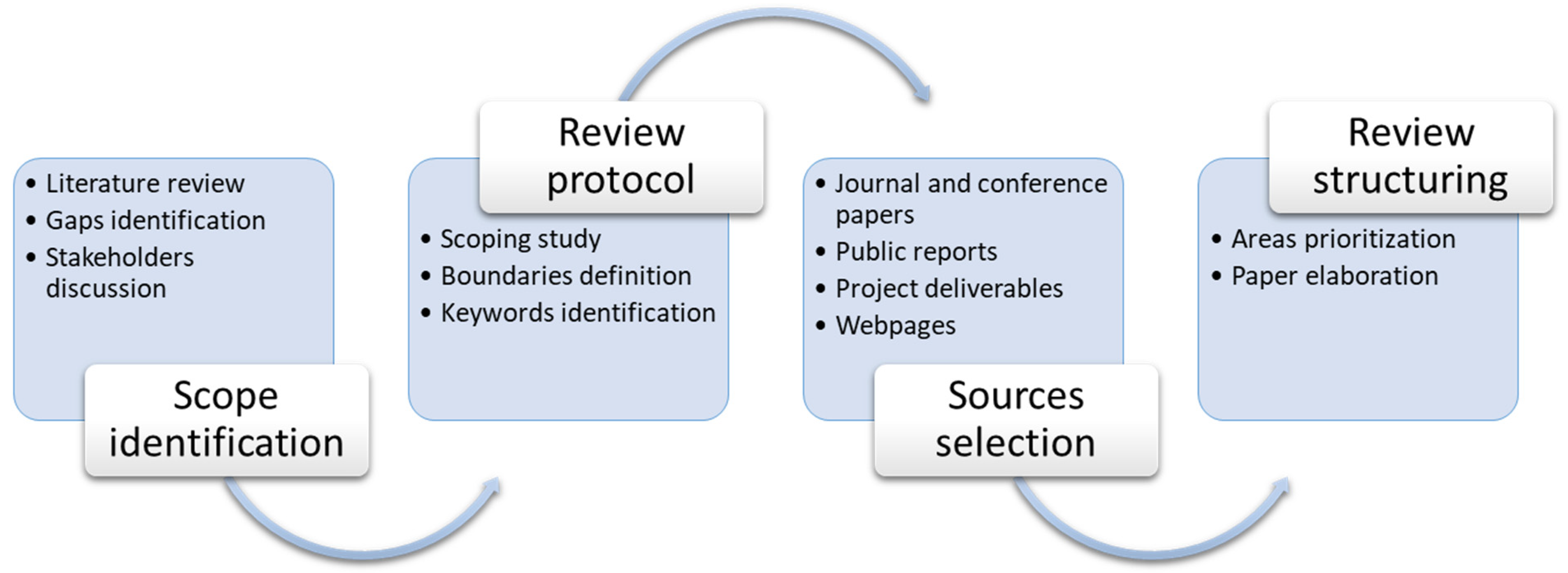
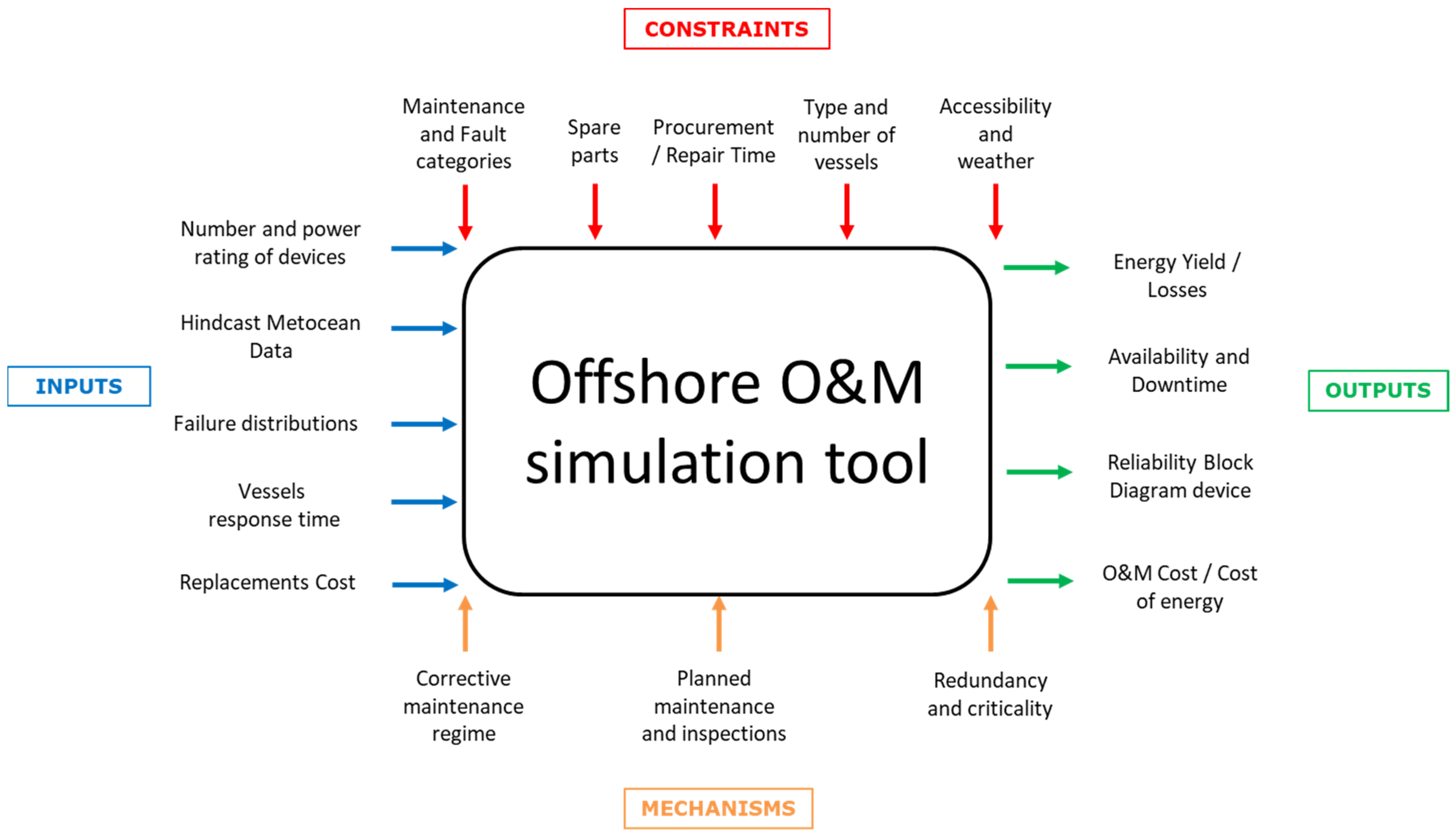


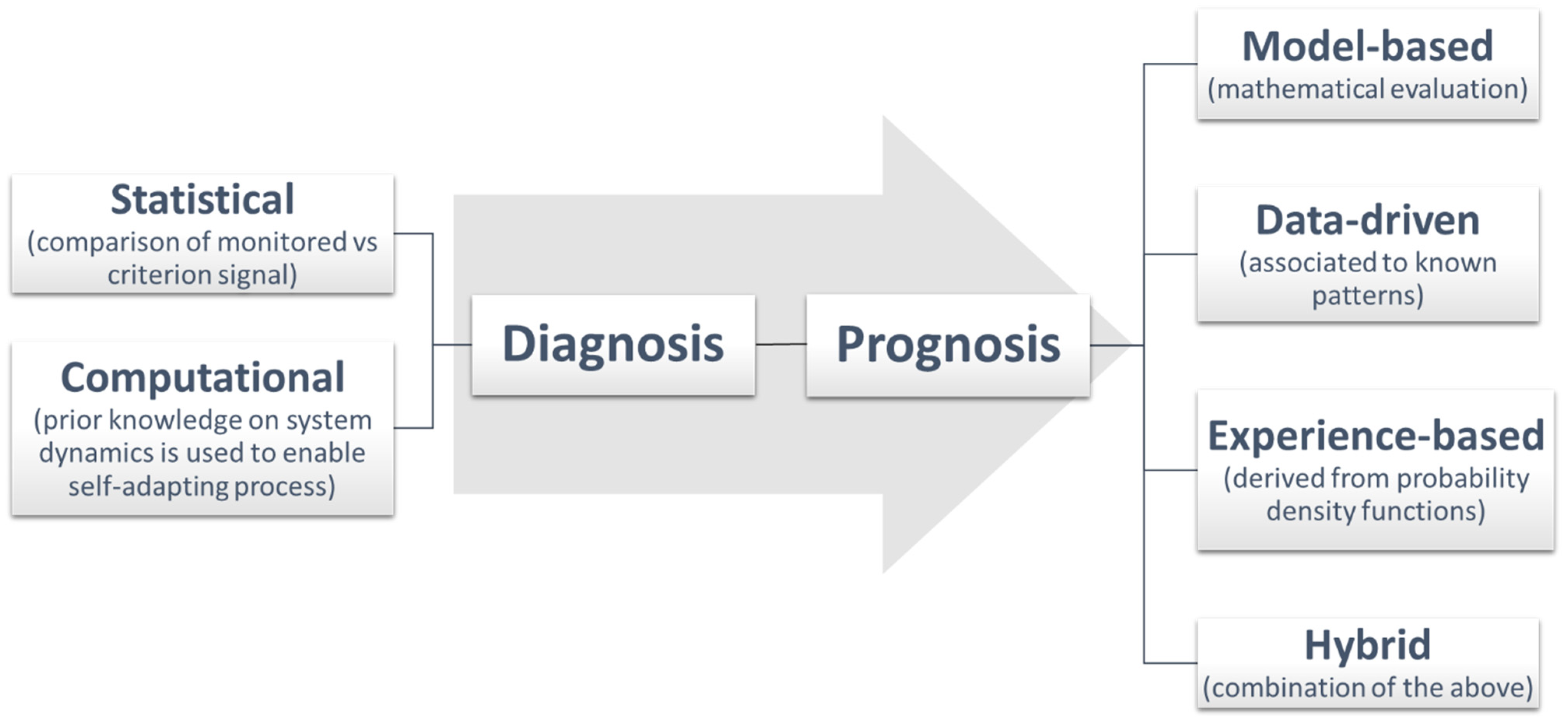
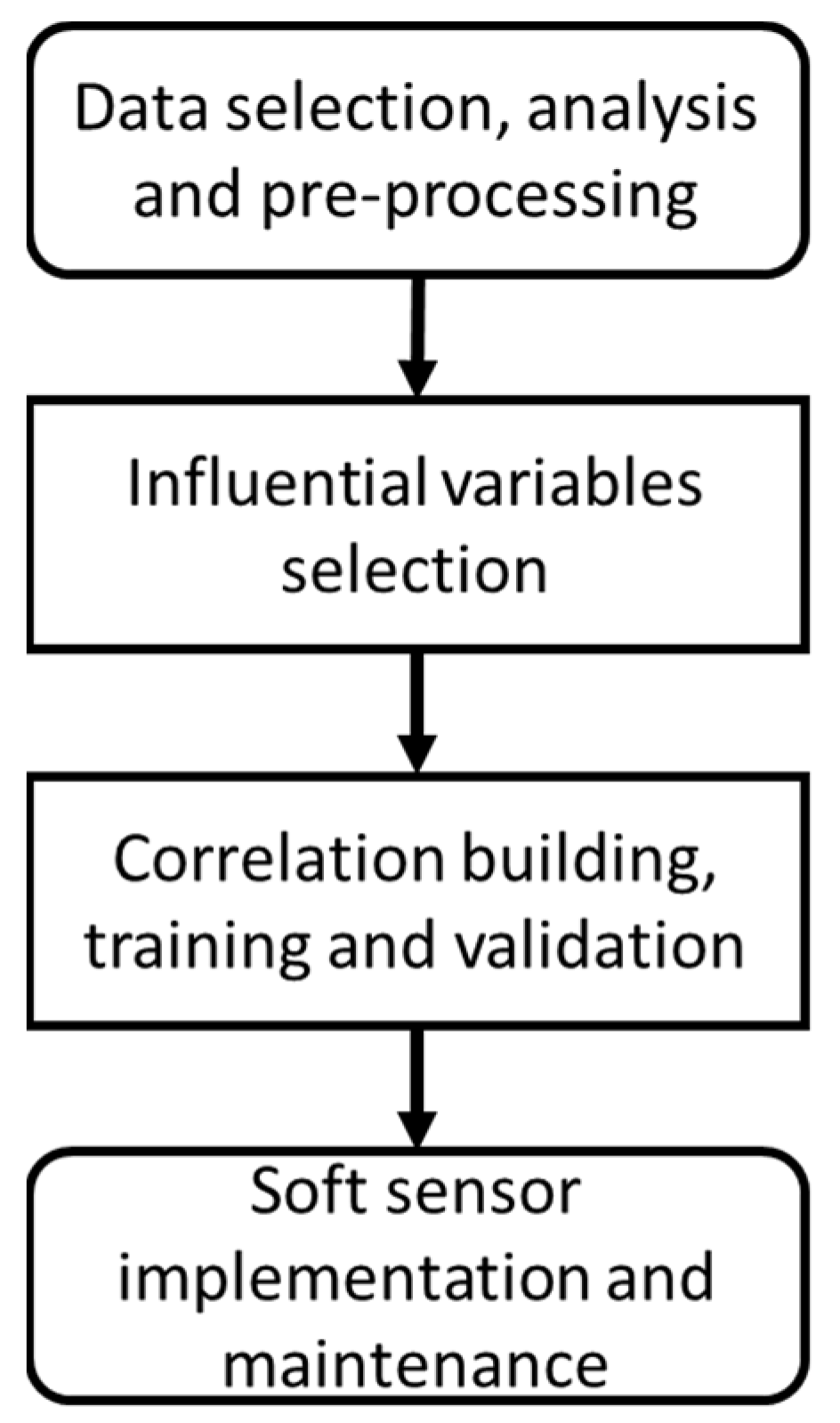
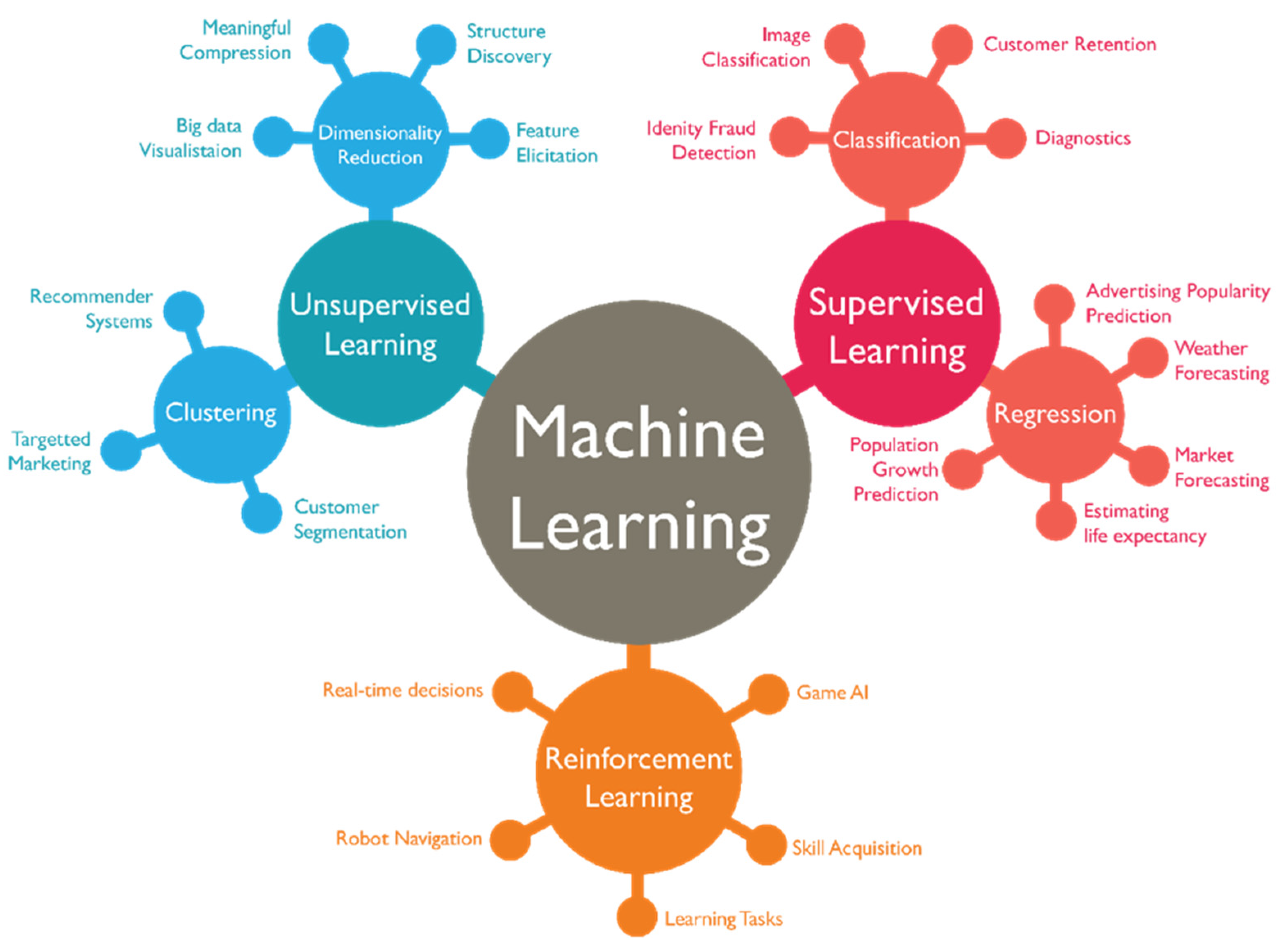
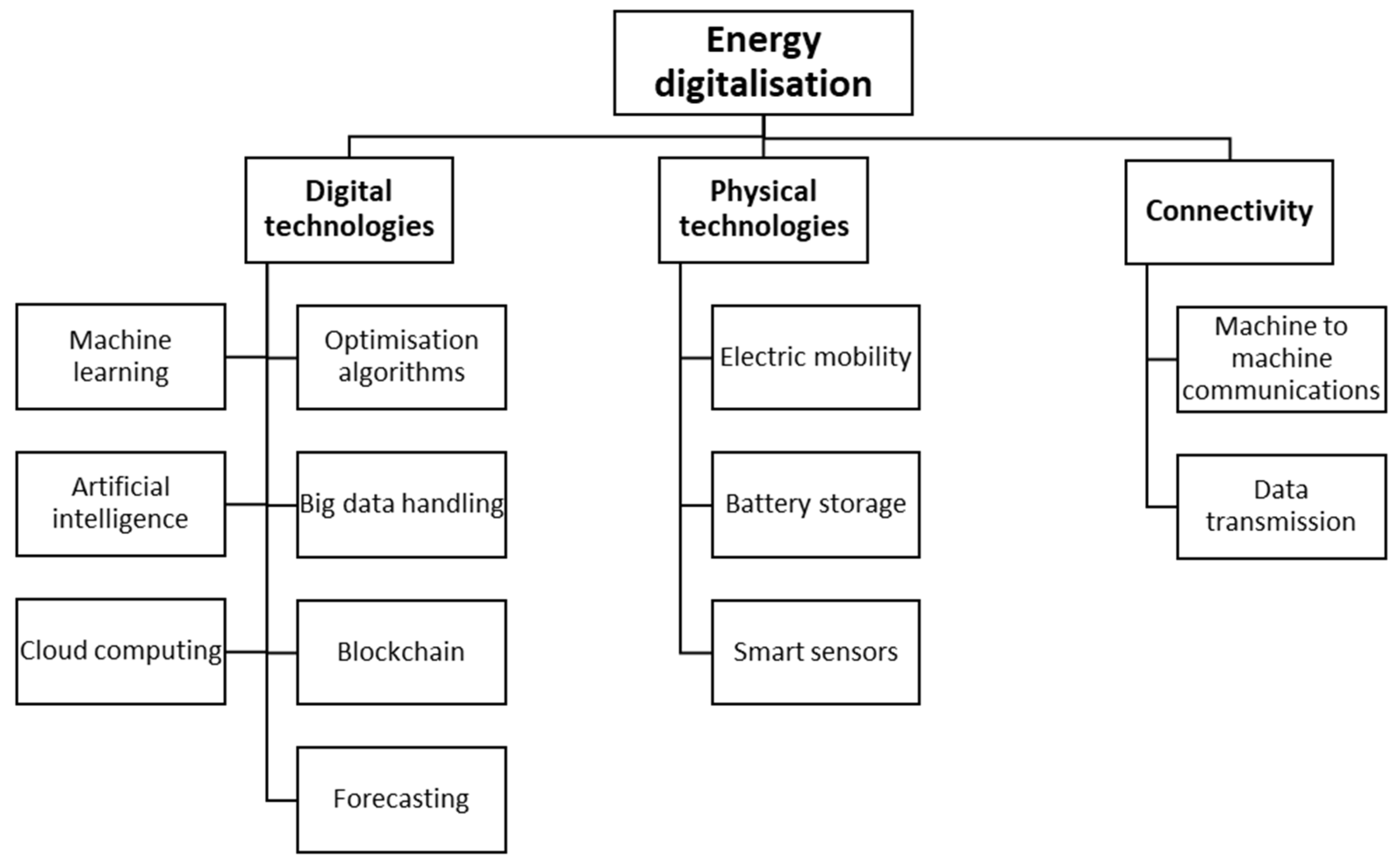
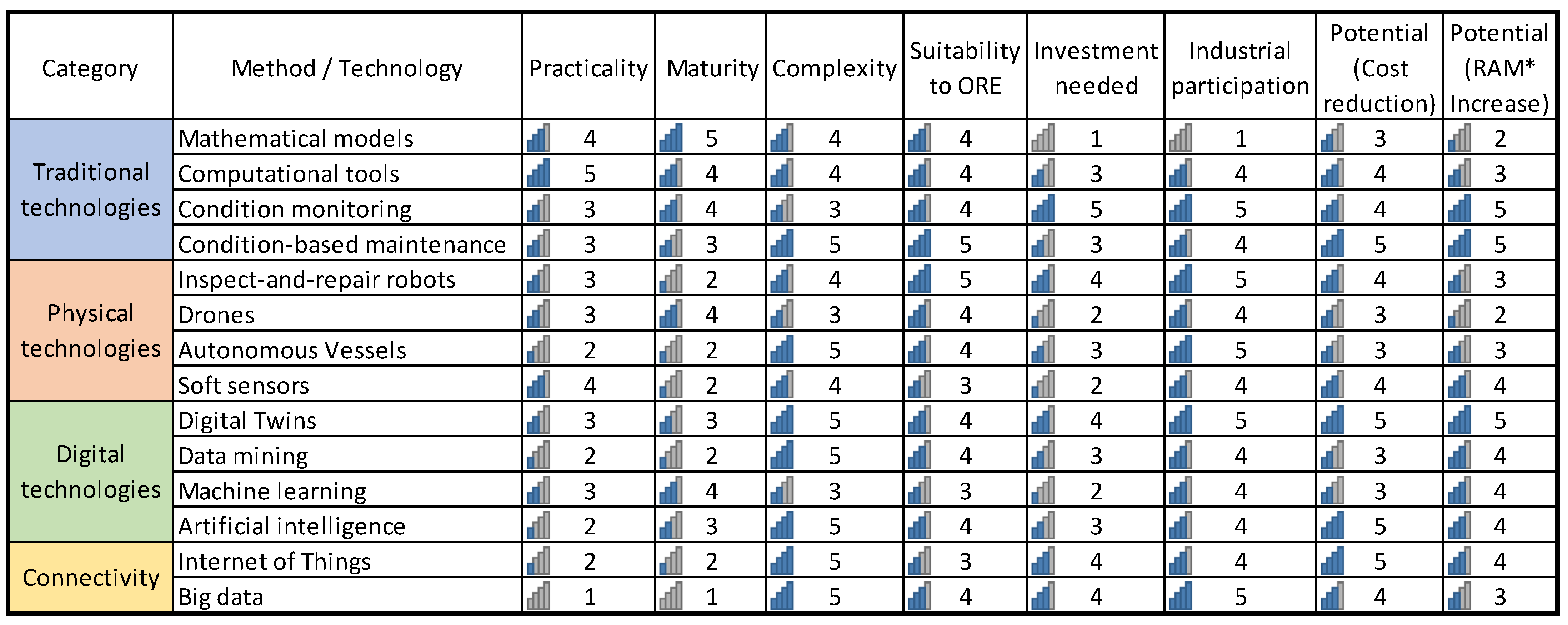
Publisher’s Note: MDPI stays neutral with regard to jurisdictional claims in published maps and institutional affiliations. |
© 2021 by the authors. Licensee MDPI, Basel, Switzerland. This article is an open access article distributed under the terms and conditions of the Creative Commons Attribution (CC BY) license (https://creativecommons.org/licenses/by/4.0/).
Share and Cite
Rinaldi, G.; Thies, P.R.; Johanning, L. Current Status and Future Trends in the Operation and Maintenance of Offshore Wind Turbines: A Review. Energies 2021, 14, 2484. https://doi.org/10.3390/en14092484
Rinaldi G, Thies PR, Johanning L. Current Status and Future Trends in the Operation and Maintenance of Offshore Wind Turbines: A Review. Energies. 2021; 14(9):2484. https://doi.org/10.3390/en14092484
Chicago/Turabian StyleRinaldi, Giovanni, Philipp R. Thies, and Lars Johanning. 2021. "Current Status and Future Trends in the Operation and Maintenance of Offshore Wind Turbines: A Review" Energies 14, no. 9: 2484. https://doi.org/10.3390/en14092484
APA StyleRinaldi, G., Thies, P. R., & Johanning, L. (2021). Current Status and Future Trends in the Operation and Maintenance of Offshore Wind Turbines: A Review. Energies, 14(9), 2484. https://doi.org/10.3390/en14092484







